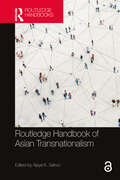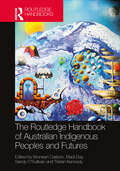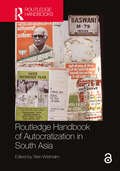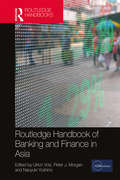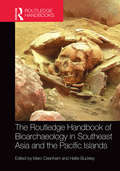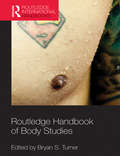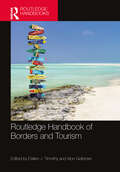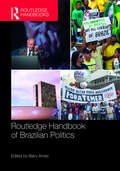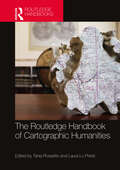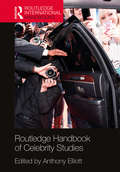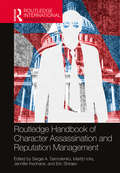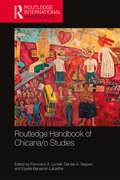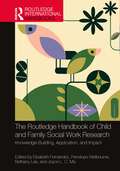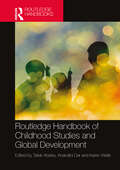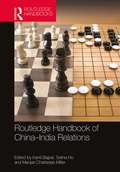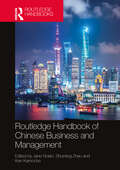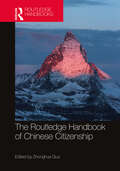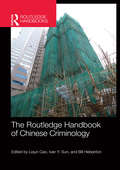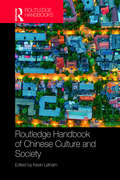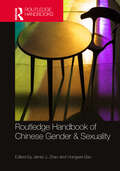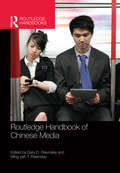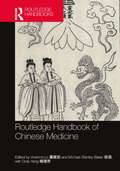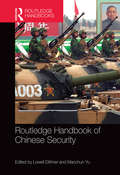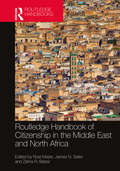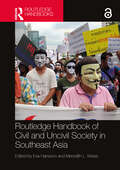- Table View
- List View
Routledge Handbook of Asian Transnationalism
by Ajaya K. SahooThis handbook presents cutting-edge research on Asian transnationalism written by experts in the areas of migration, diaspora, ethnicity, gender, language, education, politics, media, art, popular culture and literature from diverse theoretical and methodological perspectives. The Asian region not only constitutes one of the largest diasporic populations in the world but also the most diversified diasporas in terms of their historical trajectories of emigration, geographical spread, economic and political strength, socio-cultural integration in the host country and transnational engagement with the homeland. Divided thematically into six broad sections, the chapters in this handbook critically discuss and debate some of the pertinent issues of Asian transnationalism: Contextualizing Asian Transnationalism Transnationalism and Socio-Cultural Identities Transnationalism, Education and Infrastructure Transnationalism, Gender and Development Transnationalism and Dynamics of Diasporic Politics Transnationalism, Art and Media The Routledge Handbook of Asian Transnationalism will be an invaluable resource for academics, researchers and students interested in the study of international migration, Asian diaspora and transnationalism.
The Routledge Handbook of Australian Indigenous Peoples and Futures (Routledge Anthropology Handbooks)
by Bronwyn Carlson Madi Day Sandy O’Sullivan Tristan KennedyProviding an international reference work written solely by Aboriginal and Torres Strait Islander authors, this book offers a powerful overview of emergent and topical research in the field of global Indigenous studies. It addresses current concerns of Australian Indigenous peoples of today, and explores opportunities to develop, and support the development of, Indigenous resilience and solidarity to create a fairer, safer, more inclusive future. Divided into three sections, this book explores: • What futures for Aboriginal and/or Torres Strait Islander peoples might look like, and how institutions, structures and systems can be transformed to such a future; • The complexity of Aboriginal and Torres Strait Island life and identity, and the possibilities for Australian Indigenous futures; and • The many and varied ways in which Aboriginal and Torres Strait Islander peoples use technology, and how it is transforming their lives. This book documents a turning point in global Indigenous history: the disintermediation of Indigenous voices and the promotion of opportunities for Indigenous peoples to map their own futures. It is a valuable resource for students and scholars of Indigenous studies, as well as gender and sexuality studies, education studies, ethnicity and identity studies, and decolonising development studies.
Routledge Handbook of Autocratization in South Asia
by Sten WidmalmThis handbook offers a comprehensive analysis of the processes and actors contributing to autocratization in South Asia. It provides an enhanced understanding of the interconnectedness of the different states in the region, and how that may be related to autocratization. The book analyzes issues of state power, the support for political parties, questions relating to economic actors and sustainable economic development, the role of civil society, questions of equality and political culture, political mobilization, the role of education and the media, as well as topical issues such as the Covid pandemic, environmental issues, migration, and military and international security. Structured in five sections, contributions by international experts describe and explain outcomes at the national level in India, Pakistan, Bangladesh and Sri Lanka. The final section analyzes conditions for democracy and autocratization and how they are affected by the interplay of political forces at the international level in this region. India – building an ethnic state? Pakistan – the decline of civil liberties Bangladesh – towards one-party rule Sri Lanka – the resilience of the ethnic state How to comprehend autocratization in South Asia – three broad perspectives This innovative handbook is the first to describe and to explain ongoing trends of autocratization in South Asia, demonstrating that drivers of political change also work across boundaries. It is an important reference work for students and researchers of South Asian Studies, Asian Studies, Area Studies and Political Science. The Open Access version of this book, available at http://www.taylorfrancis.com, has been made available under a Creative Commons Attribution-Non Commercial-No Derivatives 4.0 license.
Routledge Handbook of Banking and Finance in Asia
by Ulrich Volz Peter J. Morgan Naoyuki YoshinoThe Routledge Handbook of Banking and Finance in Asia brings together leading scholars, policymakers, and practitioners to provide a comprehensive and cutting-edge guide to Asia’s financial institutions, markets, and systems. Part I provides a country-by-country overview of banking and finance in East, Southeast, and South Asia, including examples from China, Japan, Hong Kong, India, and Singapore. Part II contains thematic chapters, covering topics such as commercial banking, development banking, infrastructure finance, stock markets, insurance, and sovereign wealth funds. It also includes examinations of banking regulation and supervision, and analyses of macroprudential regulation, capital flow management measures, and monetary policy. Finally, it provides new insights into topical issues such as SME, green, and Islamic finance. This handbook is an essential resource for scholars and students of Asian economics and finance and for professionals working in financial markets in Asia.
The Routledge Handbook of Bioarchaeology in Southeast Asia and the Pacific Islands
by Marc Oxenham Hallie BuckleyIn recent years the bioarchaeology of Southeast Asia and the Pacific islands has seen enormous progress. This new and exciting research is synthesised, contextualised and expanded upon in The Routledge Handbook of Bioarchaeology in Southeast Asia and the Pacific Islands. The volume is divided into two broad sections, one dealing with mainland and island Southeast Asia, and a second section dealing with the Pacific islands. A multi-scalar approach is employed to the bio-social dimensions of Southeast Asia and the Pacific islands with contributions alternating between region and/or site specific scales of operation to the individual or personal scale. The more personal level of osteobiographies enriches the understanding of the lived experience in past communities. Including a number of contributions from sub-disciplinary approaches tangential to bioarchaeology the book provides a broad theoretical and methodological approach. Providing new information on the globally relevant topics of farming, population mobility, subsistence and health, no other volume provides such a range of coverage on these important themes.
Routledge Handbook of Body Studies (Routledge International Handbooks)
by Bryan S. TurnerIn the last three decades, the human body has gained increasing prominence in contemporary political debates, and it has become a central topic of modern social sciences and humanities. Modern technologies – such as organ transplants, stem-cell research, nanotechnology, cosmetic surgery and cryonics – have changed how we think about the body. In this collection of thirty original essays by leading figures in the field, these issues are explored across a number of theoretical and disciplinary perspectives, including pragmatism, feminism, queer theory, post-modernism, post-humanism, cultural sociology, philosophy and anthropology. A wide range of case studies, which include cosmetics, diet, organ transplants, racial bodies, masculinity and sexuality, eating disorders, religion and the sacred body, and disability, are used to appraise these different perspectives. In addition, this Handbook explores various epistemological approaches to the basic question: what is a body? It also offers a strongly themed range of chapters on empirical topics that are organized around religion, medicine, gender, technology and consumption. It also contributes to the debate over the globalization of the body: how have military technology, modern medicine, sport and consumption led to this contemporary obsession with matters corporeal? The Handbook’s clear, direct style will appeal to a wide undergraduate audience in the social sciences, particularly for those studying medical sociology, gender studies, sports studies, disability studies, social gerontology, or the sociology of religion. It will serve to consolidate the new field of body studies.
Routledge Handbook of Borders and Tourism
by Dallen J. Timothy Alon GelbmanThe Routledge Handbook of Borders and Tourism examines the multiple and diverse relationships between global tourism and political boundaries. With contributions from international, leading thinkers, this book offers theoretical frameworks for understanding borders and tourism and empirical examples from borderlands throughout the world. This handbook provides comprehensive overview of historical and contemporary thinking about evolving national frontiers and tourism. Tourism, by definition, entails people crossing borders of various scales and is manifested in a wide range of conceptualizations of human mobility. Borders significantly influence tourism and determine how the industry grows, is managed, and manifests on the ground. Simultaneously, tourism strongly affects borders, border laws, border policies, and international relations. This book highlights the traditional relationships between borders and tourism, including borders as attractions, barriers, transit spaces, and determiners of tourism landscapes. It offers deeper insights into current thinking about space and place, mobilities, globalization, citizenship, conflict and peace, trans-frontier cooperation, geopolitics, "otherness" and here versus there, the heritagization of borders and memory-making, biodiversity, and bordering, debordering, and re-bordering processes. Offering an unparalleled interdisciplinary glimpse at political boundaries and tourism, this handbook will be an essential resource for all students and researchers of tourism, geopolitics and border studies, geography, anthropology, sociology, history, international relations, and global studies.
Routledge Handbook of Brazilian Politics
by Barry AmesWith contributions from leading international scholars, this Handbook offers the most rigorous and up-to-date analyses of virtually every aspect of Brazilian politics, including inequality, environmental politics, foreign policy, economic policy making, social policy, and human rights. The Handbook is divided into three major sections: Part 1 focuses on mass behavior, while Part 2 moves to representation, and Part 3 treats political economy and policy. The Handbook proffers five chapters on mass politics, focusing on corruption, participation, gender, race, and religion; three chapters on civil society, assessing social movements, grass-roots participation, and lobbying; seven chapters focusing on money and campaigns, federalism, retrospective voting, partisanship, ideology, the political right, and negative partisanship; five chapters on coalitional presidentialism, participatory institutions, judicial politics, and the political character of the bureaucracy, and eight chapters on inequality, the environment, foreign policy, economic and industrial policy, social programs, and human rights. This Handbook is an essential resource for students, researchers, and all those looking to understand contemporary Brazilian politics.
The Routledge Handbook of Cartographic Humanities
by Tania Rossetto Laura Lo PrestiThe Routledge Handbook of Cartographic Humanities offers a vibrant exploration of the intersection and convergence between map studies and the humanities through the multifaceted traditions and inclinations from different disciplinary, geographical and cultural contexts.With 42 chapters from leading scholars, this book provides an intellectual infrastructure to navigate core theories, critical concepts, phenomenologies and ecologies of mapping, while also providing insights into exciting new directions for future scholarship. It is organised into seven parts: Part 1 moves from the depths of the humans–maps relation to the posthuman dimension, from antiquity to the future of humanity, presenting a multidisciplinary perspective that bridges chronological distances, introspective instances and social engagements. Part 2 draws on ancient, archaeological, historical and literary sources, to consider the materialities and textures embedded in such texts. Fictional and non-fictional cartographies are explored, including layers of time, mobile historical phenomena, unmappable terrain features, and even animal perspectives. Part 3 examines maps and mappings from a medial perspective, offering theoretical insight into cartographic mediality as well as studies of its intermedial relations with other media. Part 4 explores how a cultural cartographic perspective can be productive in researching the digital as a human experience, considering the development of a cultural attentiveness to a wide range of map-related phenomena that interweave human subjectivities and nonhuman entities in a digital ecology. Part 5 addresses a range of issues and urgencies that have been, and still are, at the centre of critical cartographic thinking, from politics, inequalities and discrimination. Part 6 considers the growing amount of literature and creative experimentation that involve mapping in practices of eliciting individual life histories, collective identities and self-accounts. Part 7 examines the variety of ways in which we can think of maps in the public realm. This innovative and expansive Handbook will appeal to those in the fields of geography, art, philosophy, media and visual studies, anthropology, history, digital humanities and cultural studies as well as industry professionals.
Routledge Handbook of Celebrity Studies (Routledge International Handbooks)
by Anthony ElliottOurs is the age of celebrity. An inescapable aspect of daily life in our media-saturated societies of the twenty-first century, celebrity is celebrated for its infinite plasticity and glossy seductions. But there is also a darker side. Celebrity culture is littered from end to end with addictions, pathologies, neuroses, even suicides. Why, as a society, are we held in thrall to celebrity? What is the power of celebrity in a world of increasing consumerism, individualism and globalization? Routledge Handbook of Celebrity Studies, edited by acclaimed social theorist Anthony Elliott, offers a remarkably clear overview of the analysis of celebrity in the social sciences and humanities, and in so doing seeks to develop a new agenda for celebrity studies. The key theories of celebrity, ranging from classical sociological accounts to critical theory, and from media studies to postmodern approaches, are drawn together and critically appraised. There are substantive chapters looking at fame, renown and celebrity in terms of the media industries, pop music, the makeover industries, soap stars, fans and fandom as well as the rise of non-Western forms of celebrity. The Handbook also explores in detail the institutional aspects of celebrity, and especially new forms of mediated action and interaction. From Web 3.0 to social media, the culture of celebrity is fast redefining the public political sphere. Throughout this volume, there is a strong emphasis on interdisciplinarity with chapters covering sociology, cultural studies, psychology, politics and history. Written in a clear and direct style, this handbook will appeal to a wide undergraduate audience. The extensive references and sources will direct students to areas of further study.
Routledge Handbook of Character Assassination and Reputation Management (Routledge International Handbooks)
by Martijn Icks Eric B. Shiraev Sergei A. Samoilenko Jennifer KeohaneIn modern politics as well as in historical times, character attacks abound. Words and images, like symbolic and psychological weapons, have sullied or destroyed numerous reputations. People mobilize significant material and psychological resources to defend themselves against such attacks. How does character assassination "work," and when does it not? Why do many targets fall so easily when they are under character attack? How can one prevent attacks and defend against them? The Routledge Handbook of Character Assassination and Reputation Management offers the first comprehensive examination of character assassination. Moving beyond studying corporate reputation management and how public figures enact and maintain their reputation, this lively volume offers a framework and cases to help understand, critically analyze, and effectively defend against such attacks. Written by an international and interdisciplinary team of experts, the book begins with a theoretical introduction and extensive description of the "five pillars" of character assassination: (1) the attacker, (2) the target, (3) the media, (4) the public, and (5) the context. The remaining chapters present engaging case studies suitable for class discussion. These include: Roman emperors; Reformation propaganda; the Founding Fathers; defamation in US politics; women politicians; autocratic regimes; European leaders; celebrities; nations; Internet campaigns. This handbook will prove invaluable to undergraduate and postgraduate students in communication, political science, history, sociology, and psychology departments. It will also help researchers become independent, critical, and informed thinkers capable of avoiding the pressure and manipulations of the media.
Routledge Handbook of Chicana/o Studies (Routledge International Handbooks)
by Francisco A. Lomelí Denise A. Segura Elyette Benjamin-LabartheThe Routledge Handbook of Chicana/o Studies is a unique interdisciplinary resource for students, libraries, and researchers interested in the largest and most rapidly growing racial-ethnic community in the United States and elsewhere which can either be identified as Chicano, Latino, Hispanic, or Mexican-American. Structured around seven comprehensive themes, the volume is for students of American studies, the Social Sciences, and the Humanities. The volume is organized around seven critical domains in Chicana/o Studies: Chicana/o History and Social Movements Borderlands, Global Migrations, Employment, and Citizenship Cultural Production in Global and Local Settings Chicana/o Identities Schooling, Language, and Literacy Violence, Resistance, and Empowerment International Perspectives The Handbook will stress the importance of the historical origins of the Chicana/o Studies field. Starting from myth of origins, Aztlán, alleged cradle of the Chicana/o people lately substantiated by the findings of archaeology and anthropology, over Spanish/Indigenous relations until the present time. Essays will explore cultural and linguistic hybridism and showcase artistic practices (visual arts, music, and dance) through popular (folklore) or high culture achievements (museums, installations) highlighting the growth of a critical perspective grounded on key theoretical formulations including borderlands theories, intersectionalities, critical race theory, and cultural analysis.
The Routledge Handbook of Child and Family Social Work Research: Knowledge-Building, Application, and Impact (Routledge International Handbooks)
by Elizabeth Fernandez Penelope Welbourne Bethany Lee Ma, Joyce L. C.This Handbook provides an accessible resource for all social work students, educators, practitioners, and policymakers to increase their knowledge and understanding of how research into the diversity and impact of child and family social work interventions might underpin and drive policy and practice.Divided into six sections The Context of Child and Family Social Work Research Preventive and Reparative Responses to Children and Families Child Maltreatment: Causes, Consequences, and Responses Alternate Care as an Approach to Safeguarding Children and Young People Intervention: Therapeutic Responses to Vulnerable Children, Youth, and Families Child and Family Social Work in the Global Context and comprising 52 newly written chapters by experts in the field, it provides a foundational overview of the field of child and family social work, including defining concepts, sentinel historical milestones, and the scope of practice. It also identifies developments in auxiliary fields such as neuroscience, psychology, education, health, poverty, and mediaBy illustrating diverse research endeavours in parenting, maltreatment, prevention, child protection, and substitutive interventions including foster care, residential care, adoption, and juvenile corrections and elaborating child welfare research methods, measures, and impacts on practice, it analyses evidence-based interventions and policies in early intervention, child protection, child placement, adoption, and advocacy. It will be required reading for anyone working in social work and child protection.
Routledge Handbook of Childhood Studies and Global Development
by Karen Wells Tatek Abebe Anandini DarThe Routledge Handbook of Childhood Studies and Global Development explores how global development agendas and processes of economic development influence children’s lives. It demonstrates that children are not only the frequent targets or objects of development but that they also shape and influence processes of economic, political and sociocultural development.The handbook makes the case for the importance of placing children at the heart of development debates and demonstrates how researchers, policymakers and practitioners can engage children in development. Through reports on field research as well as a critical engagement with theories in development studies and childhood studies, contributors contest normative assumptions about childhood and global development. They tease out and tease apart the complex social, historical, cultural, economic, epidemiological, ecological, geopolitical, and institutional processes transforming what it means to be young in the world today.Showcasing research from both established scholars and early career researchers, and with particular prominence given to the work of authors from the global south, this book will be an essential reference for policymakers, practitioners, and for researchers and students across childhood studies, education, geography, sociology, and global development.
Routledge Handbook of China–India Relations
by Manjari Chatterjee Miller Selina Ho Kanti BajpaiThe Routledge Handbook of China–India Relations provides a much-needed understanding of the important and complex relationship between India and China. Reflecting the consequential and multifaceted nature of the bilateral relationship, it brings together thirty-five original contributions by a wide range of experts in the field. The chapters show that China–India relations are more far-reaching and complicated than ever and marked by both conflict and cooperation. Following a thorough introduction by the Editors, the handbook is divided into seven parts which combine thematic and chronological principles: Historical overviews Culture and strategic culture: constructing the other Core bilateral conflicts Military relations Economy and development Relations with third parties China, India, and global order This handbook will be an essential reference work for scholars interested in International Relations, Asian Politics, Global Politics, and China–India relations.
Routledge Handbook of Chinese Business and Management
by Jane Nolan Shuming Zhao Ken KamocheThis handbook, representing the collaboration of 36 scholars, provides a multi-faceted exploration of Chinese business and management. The volume represents an ‘inside-out’ perspective, offering local knowledge and experience, in conjunction with an ‘outside-in’ approach, presenting measured and sensitive observations from an outsider’s perspective. The handbook’s approach is organised around five key themes: • Cultural and institutional contexts for business in China • Management, including digital marketing and entrepreneurship • Work and employment, covering gender and trade unions in the workplace • Human resource management and human resource development in Chinese businesses, including multinational corporations in the UK • Business and economic overviews, revealing the impact of guanxi relations and networks on Chinese business and management Revealing major recent developments in Chinese business and management alongside an appreciation of the unique historical, institutional, and cultural context of Chinese business and management, this book is a must-read for scholars, students, and educators of Chinese business and theory, and business in Asia.
The Routledge Handbook of Chinese Citizenship (China Perspectives)
by Zhonghua GuoTwo assumptions prevail in the study of Chinese citizenship: one holds that citizenship is unique to the Western political culture, and China has historically lacked the necessary conditions for its development; the other implies that China is an authoritarian regime that has always been subject to autocratic power, in which citizens and citizenship play a limited role. This volume negates both assumptions. On the one hand, it shows that China has its own unique and rich experiences of the emergence, development, rights, obligations, acts, culture, education, and sites of citizenship, indicating the need to widen the scope of citizenship studies to include non-Western societies. On the other hand, it aims to show that citizenship has been a core issue running through China's political development since the modern period, urging scholars to bring ‘citizenship’ into consideration in the study of Chinese politics. This Handbook sets a new agenda for citizenship studies and Chinese politics. Its clear, accessible style makes it essential reading for students and scholars interested in citizenship and China studies.
The Routledge Handbook of Chinese Criminology (Routledge International Handbooks)
by Bill Hebenton Ivan Y. Sun Liqun CaoAs the world’s second largest economy, China has made great progress in developing criminology. The Routledge Handbook of Chinese Criminology aims to be a key reference point to summarize the large body of literature in both Chinese and English about various aspects of crime and its control in China for international scholars with an interest in the development of criminological research on and in the Greater China region, and for everyone with a broad interest in international criminology. The editors of the handbook have selected authoritative contributors recognized for their research and scholarship on China, Hong Kong Macao, and Taiwan. This handbook consists of five sections: An account of the development of criminology as an academic discipline in modern China, as well as some of the unique theories, strategies, or philosophies of crime control that have emerged, An analysis of the criminal justice system in China, including the police, the courts, corrections, juvenile justice and the death penalty, An exploration of the issues and problems in conducting research in China, Reflections on the nature of crime and criminality in China, including drugs, prostitution, human trafficking, corruption, floating population, domestic violence, and white-collar crime, An account of crime and criminal justice in Taiwan, Hong Kong, and Macao. The book presents a coherent and comprehensive collection of essays on current research and theory in criminology, crime and justice in China and Greater China, and the Editors’ Introduction and Conclusion provide further contextualisation of the Handbook’s key themes.
Routledge Handbook of Chinese Culture and Society
by Kevin LathamThe Routledge Handbook of Chinese Culture and Society is an interdisciplinary resource that offers a comprehensive overview of contemporary Chinese social and cultural issues in the twenty-first century. Bringing together experts in their respective fields, this cutting-edge survey of the significant phenomena and directions in China today covers a range of issues including the following: State, privatisation and civil society Family and education Urban and rural life Gender, and sexuality and reproduction Popular culture and the media Religion and ethnicity Forming an accessible and fascinating insight into Chinese culture and society, this handbook will be invaluable to students and scholars across a range of disciplines, including anthropology, sociology, area studies, history, politics and cultural and media studies.
Routledge Handbook of Chinese Gender & Sexuality
by Jamie J. Zhao and Hongwei BaoThis Handbook offers a rich survey of topics concerning historical, modern and contemporary Chinese genders and sexualities.Exploring gender and sexuality as key dimensions of China’s modernisation and globalisation, this Handbook effectively situates Chinese gender and sexuality in transnational and transcultural contexts. It also spotlights nonnormative practices and emancipatory potentials within mainstream, heterosexual-dominated and patriarchally structured settings. It serves as a definitive study, research and resource guide for emerging gender and sexuality issues in the Chinese-speaking world. This Handbook covers interdisciplinary methodologies, perspectives and topics, including: History Literature Art Fashion Migration Translation Sex and desire Film and television Digital media Star and fan cultures Fantasies and lives of women and LGBTQ+ groups Social movements Transnational feminist and queer politics Paying acute attention to nonnormative genders and sexualities and emphasising the intersectionality of gender, sexuality, nationality, ethnicity and class, this Handbook offers an essential, field-defining text to Chinese gender and sexuality studies.
Routledge Handbook of Chinese Media
by Gary D. Rawnsley and Ming-yeh T. RawnsleyThe study of Chinese media is a field that is growing and evolving at an exponential rate. Not only are the Chinese media a fascinating subject for analysis in their own right, but they also offer scholars and students a window to observe multi-directional flows of information, culture and communications within the contexts of globalization and regionalization. Moreover, the study of Chinese media provides an invaluable opportunity to test and refine the variety of communications theories that researchers have used to describe, analyse, compare and contrast systems of communications. The Routledge Handbook of Chinese Media is a prestigious reference work providing an overview of the study of Chinese media. Gary and Ming-Yeh Rawnsley bring together an interdisciplinary perspective with contributions by an international team of renowned scholars on subjects such as television, journalism and the internet and social media. Locating Chinese media within a regional setting by focusing on ‘Greater China’, the People’s Republic of China, Taiwan, Hong Kong, Macau and overseas Chinese communities; the chapters highlight the convergence of media and platforms in the region; and emphasise the multi-directional and trans-national character of media/information flows in East Asia. Contributing to the growing de-westernization of media and communications studies; this handbook is an essential and comprehensive reference work for students of all levels and scholars in the fields of Chinese Studies and Media Studies.
Routledge Handbook of Chinese Medicine
by Vivienne LoThe Routledge Handbook of Chinese Medicine is an extensive, interdisciplinary guide to the nature of traditional medicine and healing in the Chinese cultural region, and its plural epistemologies. Established experts and the next generation of scholars interpret the ways in which Chinese medicine has been understood and portrayed from the beginning of the empire (third century BCE) to the globalisation of Chinese products and practices in the present day, taking in subjects from ancient medical writings to therapeutic movement, to talismans for healing and traditional medicines that have inspired global solutions to contemporary epidemics. The volume is divided into seven parts: Longue Durée and Formation of Institutions and Traditions Sickness and Healing Food and Sex Spiritual and Orthodox Religious Practices The World of Sinographic Medicine Wider Diasporas Negotiating Modernity This handbook therefore introduces the broad range of ideas and techniques that comprise pre-modern medicine in China, and the historiographical and ethnographic approaches that have illuminated them. It will prove a useful resource to students and scholars of Chinese studies, and the history of medicine and anthropology. It will also be of interest to practitioners, patients and specialists wishing to refresh their knowledge with the latest developments in the field.
Routledge Handbook of Chinese Security
by Maochun Yu Lowell DittmerLocated in the center of Asia with one of the largest land frontiers in the world and 14 neighbors whose dispositions could not easily be predicted, China has long been obsessed with security. In this handbook, an internationally renowned team of contributors provide a comprehensive and systematic analysis of contemporary thinking about Chinese national security. Chapters cover the PRC's historical, ideological and doctrinal heritage related to security, its security arrangements and policies targeting key regions and nations of the world, the security aspects of the PRC's ground, air, sea, space and cyber forces, as well as the changing and expanding definition and scope of China's security theory and practice.
Routledge Handbook of Citizenship in the Middle East and North Africa
by Roel Meijer James N. Sater Zahra R. BabarThis comprehensive Handbook gives an overview of the political, social, economic and legal dimensions of citizenship in the Middle East and North Africa from the nineteenth century to the present. The terms citizen and citizenship are mostly used by researchers in an off-hand, self-evident manner. A citizen is assumed to have standard rights and duties that everyone enjoys. However, citizenship is a complex legal, social, economic, cultural, ethical and religious concept and practice. Since the rise of the modern bureaucratic state, in each country of the Middle East and North Africa, citizenship has developed differently. In addition, rights are highly differentiated within one country, ranging from privileged, underprivileged and discriminated citizens to non-citizens. Through its dual nature as instrument of state control, as well as a source of citizen rights and entitlements, citizenship provides crucial insights into state-citizen relations and the services the state provides, as well as the way citizens respond to these actions. This volume focuses on five themes that cover the crucial dimensions of citizenship in the region: Historical trajectory of citizenship since the nineteenth century until independence Creation of citizenship from above by the state Different discourses of rights and forms of contestation developed by social movements and society Mechanisms of inclusion and exclusion Politics of citizenship, nationality and migration Covering the main dimensions of citizenship, this multidisciplinary book is a key resource for students and scholars interested in citizenship, politics, economics, history, migration and refugees in the Middle East and North Africa.
Routledge Handbook of Civil and Uncivil Society in Southeast Asia
by Eva Hansson Meredith L. WeissThe Routledge Handbook of Civil and Uncivil Society in Southeast Asia explores the nature and implications of civil society across the region, engaging systematically with both theoretical approaches and empirical nuance for a systematic, comparative, and informative approach. The handbook actively analyses the varying definitions of civil society, critiquing the inconsistent scrutiny of this sphere over time. It brings forth the need to reconsider civil society development in today’s Southeast Asia, including activist organisations' and platforms' composition, claims, resources, and potential to effect sociopolitical change. Structured in five parts, the volume includes chapters written by an international set of experts analysing topics relating to civil society: Spaces and platforms Place within politics Resources and tactics Identity formation and claims Advocacy The handbook highlights the importance of civil society as a domain for political engagement outside the state and parties, across Southeast Asia, as well as the prevalence and weight of 'uncivil' dimensions. It offers a well-informed and comprehensive analysis of the topic and is an indispensable reference work for students and researchers in the fields of Asian Studies, Asian Politics, Southeast Asian Politics and Comparative Politics.
